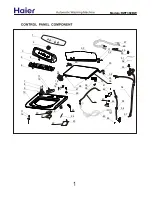
16
Operation
Always follow these general safety rules when
fueling:
1) Turn pressure washer off and allow to cool for at
least two minutes before removing any fuel cap.
Note: A running or still-hot engine is hot enough to
ignite fuel.
2) Fill fuel tank OUTDOORS
–
never indoors. Fuel
vapors can ignite if they collect inside an enclosure
and explosion can result.
3) Stay away from all sources of heat, sparks, and
flames. Do not smoke.
4) Never pump fuel directly into the gas tank at a gas
station
–
it could cause a static electric spark.
Follow these steps to avoid static electric sparking
during fueling:
•
Use an approved portable container to transfer
fuel to the pressure washer's tank. (A portable
container made of metal or conductive plastic is
preferred because it dissipates charge to ground
more readily.)
•
Always place container on the ground to be
filled. Never fill the portable gas container while
it is sitting inside a vehicle, trailer, trunk, or pick-
up truck bed.
•
Dissipate static charge from your body before
beginning the fueling process by touching a
grounded metal object at a safe distance from
fuel sources.
•
Keep nozzle in contact with container while
filling. Do not use a nozzle lock-open device.
5) Clean up fuel spills/splashes immediately.
•
If possible, move the pressure washer
away
from spilled fuel on the ground.
•
Wipe up spilled fuel and wait 5 minutes for
excess fuel to evaporate before starting engine.
•
Fuel soaked rags are flammable and should be
disposed of properly.
•
If fuel is spilled on your skin or clothes, change
clothes and wash skin immediately.
Fill Engine Fuel Tank
Check the gasoline tank level. If needed, fill tank
with fresh unleaded gasoline from a portable container:
1) Remove engine gas cap.
2) Add gasoline through the fill opening:
- Use only a UL-approved portable gasoline
container to transfer the gasoline to engine's tank.
- Do NOT overfill the gasoline tank. Allow at least
1/2" of empty space below the fill neck to allow for
fuel expansion.
3) Replace gas cap securely before starting engine.
4) Store extra gasoline in a cool, dry place in a UL-
approved tightly sealed container.
Inspect Fuel System/Check for Leaks
Inspect the engine fuel system and check for leaks
before each use.
Do not start pressure washer until all needed repairs
have been completed.
WARNING: Fuel Leak Hazard
Gasoline fuel is highly explosive and fuel leaks
can result in fire or explosions. You can be
burned and seriously injured if the fuel system is
not properly hooked up or there is a fuel leak
when you start the engine.
Inspect the entire fuel system. Look for:
•
signs of leaks or deterioration
•
chafed or spongy fuel hose
•
loose connections
•
loose or missing fuel hose clamps
•
damaged fuel tank or
•
defective gasoline shut-off valve
Inspect Spray System
Always inspect spray system for damage and leaks
before each use.
Do not start pressure washer until all
needed repairs have been completed.
















































